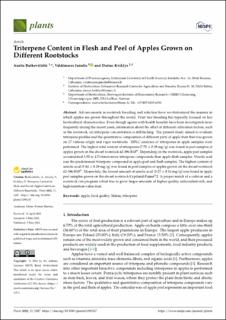| dc.contributor.author | Butkeviciute, Aurita | |
| dc.contributor.author | Janulis, Valdimaras | |
| dc.contributor.author | Kviklys, Darius | |
| dc.date.accessioned | 2022-07-20T11:20:31Z | |
| dc.date.available | 2022-07-20T11:20:31Z | |
| dc.date.created | 2022-05-11T10:30:57Z | |
| dc.date.issued | 2022-05-05 | |
| dc.identifier.citation | Plants. 2022, 11 (9), 1-14. | en_US |
| dc.identifier.issn | 2223-7747 | |
| dc.identifier.uri | https://hdl.handle.net/11250/3007214 | |
| dc.description.abstract | Advancements in rootstock breeding and selection have revolutionized the manner in which apples are grown throughout the world. Fruit tree breeding has typically focused on key horticultural characteristics. Even though agents with health benefits have been investigated more frequently during the recent years, information about the effect of different cultivation factors, such as the rootstock, on triterpene concentration is still lacking. The present study aimed to evaluate triterpene profiles and the quantitative composition of different parts of apple fruit that was grown on 17 various origin and vigor rootstocks. HPLC analyses of triterpenes in apple samples were performed. The highest total content of triterpenes (7.72 ± 0.39 mg/g) was found in peel samples of apples grown on the dwarf rootstock 62-396-B10®. Depending on the rootstock, apple peel samples accumulated 3.52 to 4.74 times more triterpene compounds than apple flesh samples. Ursolic acid was the predominant triterpene compound in apple peel and flesh samples. The highest content of ursolic acid (5.84 ± 0.29 mg/g) was found in peel samples of apples grown on the dwarf rootstock 62-396-B10®. Meanwhile, the lowest amount of ursolic acid (3.25 ± 0.16 mg/g) was found in apple peel samples grown on the dwarf rootstock Cepiland-Pajam®2. A proper match of a cultivar and a rootstock can program a fruit tree to grow larger amounts of higher quality, antioxidant-rich, and high-nutrition-value fruit. | en_US |
| dc.language.iso | eng | en_US |
| dc.publisher | MDPI, Basel, Switzerland | en_US |
| dc.rights | Navngivelse 4.0 Internasjonal | * |
| dc.rights.uri | http://creativecommons.org/licenses/by/4.0/deed.no | * |
| dc.title | Triterpene Content in Flesh and Peel of Apples Grown on Different Rootstocks | en_US |
| dc.title.alternative | Triterpene Content in Flesh and Peel of Apples Grown on Different Rootstocks | en_US |
| dc.type | Peer reviewed | en_US |
| dc.type | Journal article | en_US |
| dc.description.version | publishedVersion | en_US |
| dc.rights.holder | © 2022 by the authors | en_US |
| dc.source.pagenumber | 1-14 | en_US |
| dc.source.volume | 11 | en_US |
| dc.source.journal | Plants | en_US |
| dc.source.issue | 9 | en_US |
| dc.identifier.doi | 10.3390/plants11091247 | |
| dc.identifier.cristin | 2023386 | |
| dc.source.articlenumber | 1247 | en_US |
| cristin.ispublished | true | |
| cristin.fulltext | original | |
| cristin.qualitycode | 1 | |

